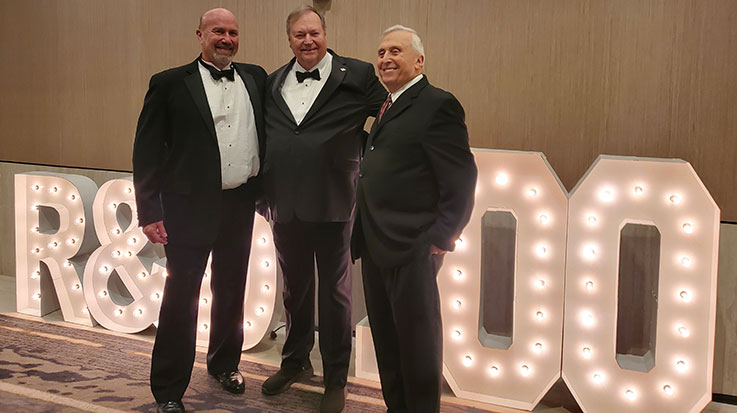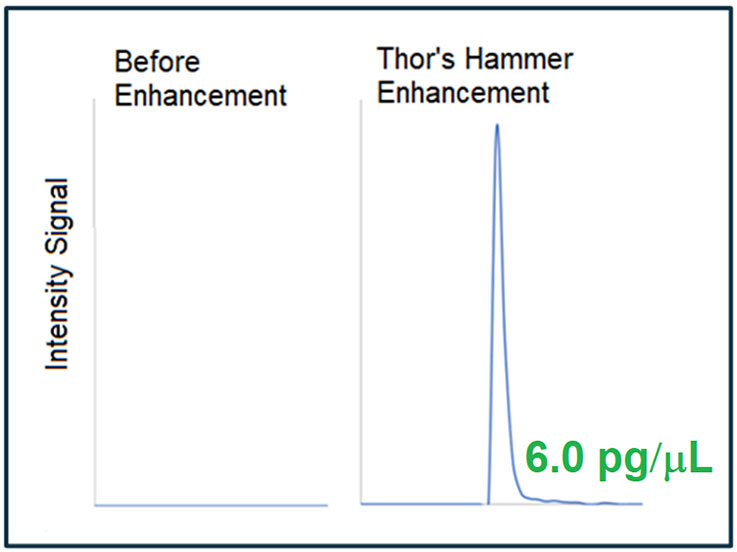Howard M. “Skip” Kingston ’73, M’75—an IUP distinguished alumnus and scholar in residence in the Madia Department of Chemistry, Biochemistry, and Physics—has earned his fourth R&D 100 Award, one of the world’s most prestigious recognitions for technological innovation. This achievement builds on a career spanning four decades and reinforces Kingston’s standing as a pioneer in analytical chemistry.

Howard M. “Skip” Kingston (center) at the R&D 100 Awards ceremony on November 20, 2025, joined by Steven Hovan, dean of the Kopchick College of Natural Sciences and Mathematics (left), and Matt Pamuku, CEO of AIT and QuantaPro (right)
The award honors Thor’s Hammer, a breakthrough technology that increases the sensitivity of any mass spectrometer by roughly 100-fold. This dramatic improvement makes it possible to accurately measure chemicals from extremely small amounts of blood—enabling the use of Quantitative Dried Blood Cards (QDBC) as a practical alternative to traditional blood draws. Demonstrations of the technology took place in IUP’s Kopchick Hall in 2024 and 2025 and will appear in upcoming joint publications with the Eden Project in the UK and IUP researchers.
How Thor’s Hammer Works
Thor’s Hammer operates using an isotopic spike enrichment technique, in which a precisely known quantity of an isotopically enriched “spike” is added to a sample containing the naturally abundant (“light”) isotopic form of the target analyte. The spike—typically consisting of approximately 80 percent isotopically enriched (“heavy”) and 20 percent natural isotope—is thoroughly mixed with the sample to ensure homogeneous distribution and isotopic equilibrium. The resulting mixture is then analyzed by mass spectrometry to measure the modified isotope ratio.
By knowing the isotopic compositions of both the natural sample and the spike, the amount of spike added, and the measured isotope ratio of the final mixture, the original concentration of the analyte in the sample can be calculated using a standard isotope dilution equation. Because both isotopic forms are measured simultaneously, this technique eliminates the need for conventional calibration curves and effectively compensates for instrument drift and variability, resulting in exceptional sensitivity, accuracy, and precision.
A key advantage of Thor’s Hammer is its universal compatibility—it integrates seamlessly with any mass spectrometer without hardware modification, including systems such as the Agilent Gas Chromatography–Mass Spectrometry (GC–MS), Agilent Inductively Coupled Plasma Mass Spectrometer, and Thermo Fisher Scientific Q Exactive Orbitrap Liquid Chromatography–Mass Spectrometry (LC–MS) platforms.
Unmatched Sensitivity
To validate its performance, Thor’s Hammer tested acenaphthene (C₁₂H₁₀), a compound commonly found in coal tar, crude oil, and byproducts of incomplete combustion. While traditional quantification failed to detect acenaphthene at 6.0 pg/μL (picograms per microliter) concentration, Thor’s Hammer yielded a clear, well-defined signal. To appreciate the sensitivity of this detection, consider that one picogram equals one trillionth (10⁻¹²) of a gram—roughly comparable to detecting a single pinch of salt dissolved in a 13,200-gallon backyard swimming pool.

Figure 1. Thor’s Hammer enhancement compared with traditional quantification for acenaphthene at 6.0 pg/μL.

Figure 2. Detection limits and uncertainties of traditional, IDMS and Thor’s Hammer methods for three specific toxins—acenaphthene, anthracene and fluoranthene.
Its versatility extends to larger carbon-based compounds like anthracene (C₁₄H₁₀) and fluoranthene (C₁₆H₁₀). Figure 2 compares the analytical performance of three quantification approaches—traditional analysis, isotope dilution mass spectrometry (IDMS), and the Thor’s Hammer method—by presenting their detection limits and associated uncertainties for three target toxins. Results confirm Thor’s Hammer consistently achieves the lowest detection limits and smallest uncertainties, detecting harmful chemicals at concentrations far below standard methods.
Real-World Impact
Thanks to this sensitivity, accurate blood testing can now be done from just a tiny spot of dried blood. As shown in Figure 3, Thor’s Hammer delivers a strong match between results from traditional venous blood draws and dried blood cards, validating the feasibility of using dried blood cards as a practical and robust alternative for sample collection and analysis, while preserving sample integrity and consistency with standard blood draw methods.

Figure 3. Comparison of results from identical blood samples processed via venous blood draw vs. dried blood card.

Figure 4. Measurement of 20 specific toxins in blood samples from nine students.
This capability was field tested in an advanced chemistry course at IUP, where nine students voluntarily analyzed their own blood card samples for 20 environmental toxins. As depicted in Figure 4, 18 of the 20 chemicals were detected, including six present in all nine students—such as common pollutants DEHP, naphthalene, toluene, xylene, PCBs, and DDT. common pollutants such as DEHP, naphthalene, toluene, xylene, PCBs, and DDT. The findings highlight an urgent public health need: simple, accurate tools for monitoring chemical exposure, especially in rural or underserved communities where full clinical blood draws may be difficult to access.
A Transformative Step for Medicine
This breakthrough unlocks the door to improved disease monitoring, earlier detection, and broader access to patient care. The blood card concept allows doctors to collect just a single drop of blood instead of a full blood draw, making it much easier to test patients in rural areas or remote areas. “The combination of Thor’s Hammer and dried blood cards is a transformative step for both science and medicine,” Kingston said. “It demonstrates how academic research, industry partnerships, and innovation can come together to improve global healthcare.” New spin-off companies have been established in partnership with IUP to commercialize the technology and bring its benefits to patients worldwide.
A Legacy of Innovation
The R&D 100 Awards, presented annually by R&D World Magazine, are often called the “Oscars of Innovation” or “Nobel Prize of Engineering.” Past winners include the ATM, LED lighting, and NASA space technologies. Founded in 1963, the awards recognize the 100 most significant new technologies worldwide each year.
Kingston’s achievement marks his fourth R&D 100 Award, following earlier honors in 1987, 1989, and 1996—cementing his legacy as a pioneer in analytical chemistry. His groundbreaking work has advanced methods now used by agencies such as the Environmental Protection Agency, Department of Defense, and NATO for definitive environmental and security analysis. His fourth R&D 100 Award not only celebrates a major scientific advance but also underscores IUP’s growing role in research that addresses global challenges in health, technology, and environmental safety.